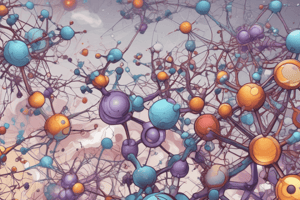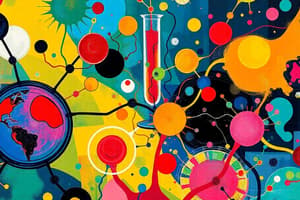Podcast
Questions and Answers
What is the study of the chemicals of living systems known as?
What is the study of the chemicals of living systems known as?
- Biochemistry (correct)
- Molecular Biology
- Biophysics
- Cell Biology
All organisms use different types of molecules for their biological functions.
All organisms use different types of molecules for their biological functions.
False (B)
List the three basic needs of a cell.
List the three basic needs of a cell.
materials, information, and energy
___ serve many purposes, including making cell membranes and providing energy.
___ serve many purposes, including making cell membranes and providing energy.
Match the following classes of foodstuffs with their primary roles:
Match the following classes of foodstuffs with their primary roles:
Which of the following statements is true regarding enzymes?
Which of the following statements is true regarding enzymes?
Cells are highly organized structural units of living organisms.
Cells are highly organized structural units of living organisms.
What are the chemical processes taking place in cells called?
What are the chemical processes taking place in cells called?
What is the primary function of the cell membrane?
What is the primary function of the cell membrane?
The nucleolus is surrounded by a nuclear membrane.
The nucleolus is surrounded by a nuclear membrane.
What type of molecules mainly compose the cell membrane?
What type of molecules mainly compose the cell membrane?
The _______ contains the cell's genetic information and is known as the information center.
The _______ contains the cell's genetic information and is known as the information center.
What percentage of nucleic acids in the cell is found within the nucleus?
What percentage of nucleic acids in the cell is found within the nucleus?
Match the cellular components with their primary functions:
Match the cellular components with their primary functions:
Proteins in the cell membrane can act as receptors for hormones.
Proteins in the cell membrane can act as receptors for hormones.
What is located in the cytoplasm?
What is located in the cytoplasm?
What is the primary function of mitochondria?
What is the primary function of mitochondria?
The Golgi apparatus is solely responsible for the synthesis of proteins.
The Golgi apparatus is solely responsible for the synthesis of proteins.
What are the two types of endoplasmic reticulum?
What are the two types of endoplasmic reticulum?
Mitochondria have a ___________ membrane structure.
Mitochondria have a ___________ membrane structure.
Match the following organelles with their primary functions:
Match the following organelles with their primary functions:
What are ribosomes primarily composed of?
What are ribosomes primarily composed of?
Smooth endoplasmic reticulum is involved in the synthesis of membrane proteins.
Smooth endoplasmic reticulum is involved in the synthesis of membrane proteins.
What are the shelf-like structures formed by the inner membrane of mitochondria called?
What are the shelf-like structures formed by the inner membrane of mitochondria called?
What is the optimum pH of lysosomes?
What is the optimum pH of lysosomes?
Lysosomes are known as the 'suicide bags' of the cell because they can digest cell components after cell death.
Lysosomes are known as the 'suicide bags' of the cell because they can digest cell components after cell death.
What substance is formed as a byproduct when peroxisomes oxidize amino acids?
What substance is formed as a byproduct when peroxisomes oxidize amino acids?
Water constitutes _____% of the protoplasm in living matter.
Water constitutes _____% of the protoplasm in living matter.
Match the following functions with their correct descriptions:
Match the following functions with their correct descriptions:
Which of the following statements is NOT a function of water in the cell?
Which of the following statements is NOT a function of water in the cell?
Peroxisomes contribute to cell protection by converting H2O2 into harmless substances.
Peroxisomes contribute to cell protection by converting H2O2 into harmless substances.
The process of self-digestion in cells following their death is known as _____ .
The process of self-digestion in cells following their death is known as _____ .
Which type of organism is characterized by having no defined nucleus?
Which type of organism is characterized by having no defined nucleus?
All life processes consist of reactions catalyzed by enzymes.
All life processes consist of reactions catalyzed by enzymes.
What are the components upon which hormones and neurotransmitters depend?
What are the components upon which hormones and neurotransmitters depend?
The five kingdoms of life include Monera, Protista, Fungi, Plantae, and _____
The five kingdoms of life include Monera, Protista, Fungi, Plantae, and _____
Which of the following is NOT a common biochemical reaction?
Which of the following is NOT a common biochemical reaction?
Match the following nutritional needs with their types:
Match the following nutritional needs with their types:
Eukaryotic cells do not contain organelles.
Eukaryotic cells do not contain organelles.
Name a type of eukaryotic organism that can be unicellular.
Name a type of eukaryotic organism that can be unicellular.
Flashcards are hidden until you start studying
Study Notes
Introduction to Biochemistry
- Biochemistry studies the chemical processes and composition of living organisms.
- Chemical reactions underpin every biological activity, with hundreds to thousands occurring in cells every minute.
- Five central principles define living organisms:
- Cells are the basic structural units of all life.
- Living processes involve numerous chemical reactions.
- Fundamental reaction pathways are universal across organisms.
- All organisms utilize the same types of molecules.
- Growth, development, and reproduction instructions are encoded in nucleic acids.
- Cells and organisms require materials, information, and energy for survival.
- Major classes of organic materials essential for life include carbohydrates, lipids, and proteins.
- Carbohydrates provide energy and structural components in plants and animals.
- Lipids form cell membranes and serve as energy sources.
- Proteins play critical roles in cellular structure and function, acting as enzymes to facilitate reactions.
- Enzymes and hormones are crucial for cellular information systems, directing biochemical activity based on genetic encoding in nucleic acids.
- Metabolism encompasses all chemical reactions within cells, often involving common reactions like nucleophilic substitution, elimination, addition, isomerization, oxidation-reduction, and hydrolysis.
- Nutritional needs for life include vitamins, minerals, water, and oxygen.
Cell Structure
- Organisms are categorized into two main groups based on cell structures:
- Prokaryotes: Unicellular organisms without a nucleus (e.g., bacteria).
- Eukaryotes: Organisms with a defined nucleus; can be unicellular or multicellular (e.g., animals and plants).
Five Kingdoms of Life
- Monera: Prokaryotic organisms, including bacteria and cyanobacteria.
- Protista: Unicellular eukaryotes, such as yeasts and Amoeba.
- Fungi: Multicellular eukaryotes like molds and mushrooms.
- Plantae: Multicellular eukaryotes, including higher plants.
- Animalia: Multicellular eukaryotes, including animals.
Key Cell Organelles
- Cell Membrane: Semi-permeable lipid bilayer that maintains cell integrity and regulates nutrient absorption.
- Nucleus: Information center of the cell, housing genetic material and synthesizing DNA and RNA.
- Nucleolus: Substructure of the nucleus, rich in RNA, involved in mRNA synthesis.
- Cytoplasm: Aqueous cell interior containing organelles, enzymes, and metabolites.
- Mitochondria: Powerhouse of the cell, where energy is produced via ATP synthesis from substrates like carbohydrates and lipids.
- Endoplasmic Reticulum (ER): Network of tubules; Rough ER synthesizes proteins, Smooth ER synthesizes lipids and participates in detoxification.
- Ribosomes: Sites of protein synthesis, comprised of ribosomal RNA and proteins.
- Golgi Apparatus: Packaging and distribution center for proteins and cell products.
- Lysosomes: Contain digestive enzymes for breaking down cellular waste and pathogens; known as "suicide bags."
- Peroxisomes: Contain enzymes that oxidize fatty acids and toxic substances, converting hydrogen peroxide to water and oxygen.
Protoplasm Composition
- Composed of:
- Bioinorganic substances: water (70-90% of cell mass) and inorganic salts (e.g., Na, K, Ca).
- Bioorganic compounds: proteins, lipids, carbohydrates, and nucleic acids.
Role of Water in Cells
- Acts as a solvent, facilitating movement and transfer of substances within the body.
- Participates in biochemical reactions through ionization, essential for many metabolic processes.
- Regulates body temperature due to high specific heat and heat conductivity, also aiding in cooling via evaporation.
Properties of Chemical Reactions In Vivo
- Chemical reactions occurring in living organisms possess unique properties essential for life processes.
Studying That Suits You
Use AI to generate personalized quizzes and flashcards to suit your learning preferences.




